Teaching your puppy tricks is a fantastic way to bond, provide mental stimulation, and build a well-behaved companion. These easy puppy tricks can help them develop impulse control, improve their behavior, and strengthen your relationship. With patience, positive reinforcement, and delicious treats, you’ll be amazed at how quickly your furry friend learns!
1. Sit
 Puppy Sitting
Puppy Sitting
“Sit” is often the first command taught to puppies, and for good reason. It’s a fundamental trick that provides a foundation for more advanced training. A puppy who understands “sit” is better equipped to learn other commands and exhibit calmer behavior.
How to Teach Your Puppy to Sit
- Lure with a Treat: Hold a high-value treat close to your puppy’s nose. While they are standing, slowly move the treat over their head, towards their tail. This motion will naturally encourage them to lower their rear into a sitting position.
- Add the Command: As your puppy starts to sit, say the command “Sit” clearly and enthusiastically. The instant their rear touches the ground, reward them with the treat and positive reinforcement, such as “Good sit!”
- Repetition is Key: Repeat this process several times, keeping the training sessions short and fun. Consistency will help your puppy associate the word “Sit” with the action of placing their rear on the ground.
2. Stay
 Puppy Staying
Puppy Staying
Teaching your puppy to “Stay” is a valuable skill for building self-control and preventing unwanted behaviors. It’s an excellent way to keep your puppy safe in various situations and to manage their impulses.
How to Teach Your Puppy to Stay
- Begin with “Sit”: Have your puppy sit. Once they’re sitting comfortably, reward them.
- Introduce the “Stay” Command: While your puppy is in the “sit” position, say “Stay” in a firm, clear voice. Hold your hand up in a “stop” gesture.
- Short Durations: Initially, only ask your puppy to stay for a second or two. If they remain in place, reward them with a treat and praise. Gradually increase the amount of time you ask them to stay.
- Release Word: Introduce a release word like “Okay” or “Free” to signal that they are no longer required to stay.
3. Come
 Puppy Coming When Called
Puppy Coming When Called
The “Come” command is crucial for your puppy’s safety and your peace of mind. A reliable recall can prevent your puppy from running into dangerous situations and allows you to safely let them off-leash in appropriate areas.
How to Teach Your Puppy to Come
- Start in a Safe Area: Begin training in a confined, safe space like your living room or backyard.
- Use a Happy Tone: Say your puppy’s name followed by the command “Come” in an enthusiastic, happy voice.
- Encourage Movement: As your puppy moves towards you, get down on their level and encourage them with praise and open arms.
- Reward Generously: When your puppy reaches you, reward them with a high-value treat, lots of praise, and maybe even a cuddle. This positive reinforcement will create a strong association between coming to you and good things happening.
- Gradually Increase Distance: As your puppy improves, gradually increase the distance between you when you call them.
4. Leave It
 Puppy Learning to Leave It
Puppy Learning to Leave It
The “Leave It” command is essential for protecting your puppy from ingesting potentially harmful objects. It teaches them to resist temptation and to look to you for guidance.
How to Teach Your Puppy “Leave It”
- Start with a Treat in Your Hand: Place a treat in your closed fist and present it to your puppy. Let them sniff and paw at your hand.
- Say “Leave It”: As your puppy tries to get to the treat, say “Leave it” in a firm voice.
- Reward the Correct Response: The moment your puppy stops trying to get the treat, even for a second, praise them and give them a treat from your other hand. This teaches them that ignoring the first treat leads to a reward.
- Progress to an Open Hand: Once your puppy consistently leaves the treat in your closed hand, progress to placing a treat in your open palm. Repeat the process, rewarding them when they ignore the treat in your open hand.
- Generalize the Command: Eventually, you can use “Leave It” with objects on the floor or in other situations.
5. Down
 Puppy Lying Down
Puppy Lying Down
“Down” is a useful command for calming your puppy and encouraging relaxation. It can be particularly helpful in situations where you want your puppy to be still and quiet.
How to Teach Your Puppy “Down”
- Start with “Sit”: Have your puppy sit.
- Lure with a Treat: Hold a treat close to your puppy’s nose.
- Move the Treat Downward: Slowly move the treat down towards the floor, encouraging your puppy to follow it with their nose.
- Encourage Lying Down: As your puppy lowers their body to reach the treat, say “Down.”
- Reward: When your puppy is fully lying down, reward them with the treat and praise.
6. Shake
 Puppy Shaking Paw
Puppy Shaking Paw
“Shake” is a charming and interactive trick that’s easy to teach and impresses friends and family. It involves your puppy offering their paw in exchange for a reward.
How to Teach Your Puppy “Shake”
- Start with “Sit”: Have your puppy sit.
- Hold a Treat: Hold a small treat in one hand.
- Tap Their Paw: Gently tap one of your puppy’s front paws with your other hand.
- Say “Shake”: As you tap their paw, say the command “Shake.”
- Reward the Lifted Paw: Most puppies will instinctively lift their paw. When they do, take their paw in your hand, say “Good shake!” and give them the treat.
Final Tips for Successful Puppy Training
 Puppy Training Tips
Puppy Training Tips
Teaching your puppy tricks should be a positive and enjoyable experience for both of you. Remember these key tips:
- Keep Training Sessions Short: Puppies have short attention spans. Aim for training sessions of 5-10 minutes, several times a day.
- Use Positive Reinforcement: Reward your puppy with treats, praise, and affection when they perform the desired behavior. Avoid punishment, as it can create fear and anxiety.
- Be Consistent: Use the same commands and hand signals every time. This will help your puppy understand what you’re asking of them.
- Be Patient: Every puppy learns at their own pace. Don’t get discouraged if your puppy doesn’t pick up a trick immediately. Just keep practicing and be patient.
- Make it Fun: Keep training sessions lighthearted and enjoyable. If you and your puppy are having fun, you’re more likely to succeed.
With these easy puppy tricks and a consistent, positive approach, you’ll be well on your way to having a well-behaved and happy companion. Remember to celebrate your puppy’s successes and enjoy the bonding experience that comes with training.
